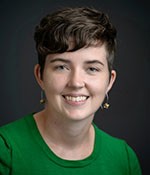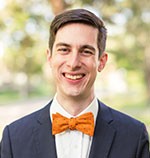2022 Summer Research Grant Awardees

Dr. Grant Berry
Department of Romance Languages and Literatures, Spanish Studies
College of Liberal Arts and Sciences
Project Title: Network Structure and the Adoption of Dialectal Variation
The proposed research sheds light on the interplay between social interaction and language structure, utilizing a database of personal narratives from minority speakers in Philadelphia living on the threshold between two distinct varieties of English. Specifically, I will work with two undergraduate researchers to expand the Puerto Rican English in Philadelphia (PREP) corpus with additional speech data from 37 people. We will then extract samples of four key language features, two from each of the major English varieties in Philadelphia that have been documented to date. Kinship data from surveys will be used alongside qualitative analysis of the participants’ oral histories to construct a formal social network, and graph-theoretic metrics will be employed to quantify each individual’s role in that network. Finally, we will investigate how network structure influences adoption of each of the four language features under study in order to determine how one’s interactions may influence one’s way of speaking.

Dr. Sherry Burrell
and
Dr. Meredith MacKenzie Greenle
Department of Nursing
M. Louise Fitzpatrick College of Nursing
Project Title: Health-Related Quality of Life Over Time in Older Adult Survivors of Colorectal Cancer
Colorectal cancer (CRC) is the third most common cancer diagnosis and the second most common cause of cancer-related mortality. Because cancer is a disease of aging, cancer diagnosis is more common among older adults. The aging of the world population, coupled with advances in early cancer detection and treatment, has resulted in more older adults surviving cancer than ever before. Older adult survivors of CRC are living longer and experiencing the effects of CRC cancer and its treatments; therefore, it is increasingly more important to determine whether these additional years of life are high-quality years. As such, understanding the factors that affect the quality of life among older adult survivors of CRC over time is a priority research topic. In particular, understanding how quality of life varies over time among older adult survivors of CRC will enable health care providers to develop strategies to improve quality of life in this population. As such, the purpose of this study is to explore the trajectories of quality of life and factors related to quality of life over time among older adult survivors of CRC. This is the first step toward improving outcomes for long-term older adult survivors of CRC and their families. Insights from this study may serve to inform clinical assessments and advance multidisciplinary survivorship care planning for older adult survivors of CRC and their families.

Dr. David Cereceda
Department of Mechanical Engineering
College of Engineering
Project Title: Elucidating Fatigue Strength in Metals Through Physics-Informed Machine Learning
Mechanical fatigue is a failure mechanism that occurs when materials are subject to cyclic loading. Despite being observed as early as the first half of the 19th century, it remains responsible for 55% of the failures occurring in aircraft components. Furthermore, it has cost the U.S. economy an average of $232 billion annually since 2010. This University Summer Grant (USG) project aims to improve the fundamental understanding of this type of mechanical deformation by implementing three physics-informed machine learning algorithms. Principle component analysis (PCA) will be applied to ascertain what inclusion shape characteristics led to cracking. Density-based spatial clustering of applications with noise (DBSCAN) will be applied to partition active and not active slip systems given the amount of accumulated slip determined through crystal plasticity modeling. K-nearest neighbor (KNN) classification will be used to predict active slip systems based on a grain’s orientation measured from an Electron backscatter diffraction (EBSD) scan. The proposed approach will not only advance the fundamental understanding of fatigue but also help in its prevention.

Dr. Alice Dailey
Department of English
College of Liberal Arts and Sciences
Project Title: Arden Fourth Series Edition of Shakespeare's Measure for Measure
This grant supports the first stages of work on a new edition of Shakespeare's Measure for Measure for the Arden Shakespeare. The Arden Shakespeare produces the most scholarly editions of Shakespeare’s plays; editors of the newly commissioned Fourth Series have the opportunity to leave an indelible mark on an important text. Arden editions are used worldwide: by high schools, universities, and scholars; by actors, theatre directors, and dramaturgs; by journalists who follow the arts; and by everyday readers interested in Shakespeare. I am particularly excited to be editing Measure for Measure, which has steadily risen to a place of prominence in the Shakespearean canon over the past two decades due to the play’s dramatization of coercive gendered power—a dramatization that has been eerily replayed in events like the Anita Hill and Christine Blasey Ford hearings and the trials of Bill Cosby and Harvey Weinstein. I will be the first woman scholar to edit this play for the Arden Shakespeare.

Dr. Denise Downey
Department of Accounting
School of Business
Project Title: Multinational Company Audits and Firm Quality Control
Investor protection hinges on the ability of accounting firms to provide assurance on the financial information released by public companies. For multinational companies, the firm leading the audit typically relies on other firms within their network to audit components of the company in foreign jurisdictions. Achieving a global audit quality standard is advantageous for the global network firms (GNFs) as it relates to multinational company audits because it lowers supervision and monitoring costs for the lead firm, and guards against reputational risk for the entire network or brand. While achieving global audit quality is important, regulators and academic research identify concerning audit quality issues in multinational company audits (e.g., PCAOB 2016; Burke, Hoitash, and Hoitash 2020; Downey and Westermann 2021). Given the limited nature of U.S. regulatory inspections in foreign jurisdictions, firms play a critical role in driving the global consistency and quality of multinational company audits on which U.S. investors and markets depend. The internal inspection process is an important firm-level quality control mechanism used to facilitate global audit quality. Notably, due to the legal structure of the GNFs, lead and component auditors are subject to separate internal inspections by their respective member firms. This project aims to study the internal inspection process, specifically as it relates to multinational company audits, with the objective of identifying contextual factors that affect auditors’ perception of the internal inspection process, and to better understand whether (and how) those perceptions ultimately impact the effectiveness of this quality control mechanism.

Dr. Joseph Drury
Department of English
College of Liberal Arts and Sciences
Project Title: Humans, Machines, Automatons
This project examines the evolving cultural meaning of the automaton in Enlightenment British literature. In the early eighteenth century, the anxieties excited by the automata displayed in assembly rooms across Europe focused on the atheism, immorality, and social unrest they appeared to authorize. Novels and plays featuring unscrupulous libertines claiming to be mere machines spoke to contemporary fears about that the threat that new philosophical and scientific accounts of the human subject posed to orthodox ideas about the freedom of the will. In the late eighteenth century, however, the meaning of the automaton began to change. In Jean-Jacques Rousseau’s novel Julie, or The New Heloise (1761), the figure of the human machine has lost its associations with chaos and sexual abandon and has become instead a figure for the conformity, inauthenticity, and alienation to which individuals were reduced in modern, artificial societies. While recent historical scholarship has read late eighteenth-century resistance to the automaton as evidence of a new consciousness of a new “vitalist” rejection of mechanical accounts of the human subject, I argue that novels such as Evelina (1778) and Camilla (1792) by Frances Burney and Charles Dibdin’s Hannah Hewitt, or, The Female Crusoe (1792) suggest rather a new sense of the dangerous moral and political implications of the affinities between humans and machines.

Dr. Travis Foster
Department of English
College of Liberal Arts and Sciences
Project Title: Womanish: Variant Femininities of the American Nineteenth Century
How were feminine men, feminine boys, and trans feminine individuals understood before identity categories like gay man and transgender woman? This project provides an answer in what will be the first monograph-length study of nonconforming femininity in the nineteenth-century US. By recovering modes of feminine expression available before the advent of sexual orientation and gender identity, and by considering literary and cultural representations that track larger patterns in the relationship between gender nonconformity, race, sex, and socioeconomics, the book will tell a story of lost possibilities and forgotten modes of understanding gender and sexual life. It aims to learn from the variant gender expressions of the past, to highlight those cultural alternatives innovated by previous eras’ social forms, and to help us better understand entangled histories between a previous era’s gender alternatives and the gay and trans identities of the present.

Dr. Danielle Gadson and
Dr. Seri Park
Department of Public Administration
College of Liberal Arts and Sciences
Project Title: Understanding Strategies for Transportation Equity in Government-Subsidized Opioid Treatment Programs
Various clinical and social factors including social stigma about drug use, lack of insurance coverage, confounding co-morbidities, and dispassionate care from health care providers cloud the effect of government-subsidized MAT initiatives for historically disenfranchised groups. This research project focuses on the specific risk factor of transportation access as a social barrier to successful enrollment and completion of government-subsidized MAT programs. Transportation equity is a particularly important issue within this context as MAT plans are highly dependent on access to a reliable and timely transportation. Enrolled patients receive medication on a strictly supervised and rigid schedule and undergo periodic random drug testing. Follow-up often requires weekly, if not daily in-person contact even for outpatient care. Thus, the nature of this intervention coupled with a lack of earmarked opioid-specific transportation funds, creates a unique implementation challenge for public health leaders seeking equitable outcomes for government-subsidized MAT programming. This project seeks to document the mitigation efforts of public administrators faced with this dilemma to highlight the ingenuity of public administrators when faced with less-than-ideal funding environments and to bring legislative awareness to the issue of transportation equity.

Dr. Brett Grainger
Department of Theology and Religious Studies
College of Liberal Arts and Sciences
Project Title: Music, Mysticism, and Racial Ambiguity in the Solo Concerts of Keith Jarrett
This research project investigates the intersections of music, mysticism, and racial ambiguity in the reception of Keith Jarrett, a jazz musician who rose to international fame during the 1970s on the back of his improvised solo piano concerts. My project centers confusion over Jarrett’s ambiguous racial identity because such ambiguity was important to Jarrett’s iconicity both as a musician and a spiritual figure who embodied a vision of artistic, racial, and spiritual “miscegenation.” Looking at a range of popular cultural materials—including promotional materials, liner notes, interviews, and concert and album reviews, my research demonstrates the connections critics and audiences made between Jarrett's transgressive fusion of art and commerce, jazz and classical, composition and improvisation, with his transgression of racial boundaries and binaries, and how this transgression was related to cultural ideals of spiritual transcendence. Focusing on the cultural production of Jarrett’s solo performances in the 1970s, this chapter connects racial ambiguity with a certain reception of mysticism. It asks: What does it mean for a white musician to channel or manifest Blackness? How were Jarrett’s projects of racial, musical, and spiritual “miscegenation” understood as being mutually dependent by critics, audiences, recording companies, and the artist himself? And how was an assimilative notion of “whiteness” a normative condition for their success?

Dr. Zuyi (Jacky) Huang
Department of Chemical Engineering
College of Engineering
Project Title: Development of Synthetic Mucins as a Universal Platform to Investigate Strategies for Regulating Gut Microbiome Colonization
The Human-Gut Microbiome is responsible for the metabolism of the food products ingested in the human diet resulting in byproducts that are crucial for human health. The human bodies, including intestines, produce more than a liter of the slippery substance every day, covering a surface area of more than 400 square meters to trap and disarm microbial invaders. Mucus is primarily composed of mucins that consist of a protein core and a high number of O-linked glycans. These O-glycans provide initial attachment sites to gut micro which carry surface proteins bind the mucus. Bacteria with mucolytic activity can release monosaccharides from mucin O-glycans and metabolize them.
While mucin glycosylation is known for its impact on bacterial attachment and colonization, no quantitative approach has been presented to systematically optimize the type and the amount of glycosylation for the binding of the surface proteins of gut microbiome. In this study, a computational platform will be developed to investigate how the type and the amount of glycosylation influence the interaction of mucins with the mucus-binding proteins on the surface of gut bacteria. The hypothesis behind this work is the mucus made of synthetic mucins with higher binding affinity to the mucin-binding proteins on the surface of gut bacteria should facilitate the growth and colonization of gut microbiome. The findings from the computational approach will be tested in synthesized mucins in lab and evaluated against the community consisting of gut bacteria to accelerate the development of synthetic mucins for regulating gut microbiome colonization.

Dr. Jeremey Kees
Department of Marketing & Business Law
School of Business
Project Title: Direct and Indirect Effects of Thin Spokesmodels in Advertising: The Mediating Role of Body Esteem
This research is designed to examine how young females respond to the use of thin models in advertising and the implications of these responses for advertisers. This research will contribute to the understanding of how thin spokesmodels can attenuate body esteem for young females and lead to negative marketing-related outcomes. This research seeks to make an original and important contribution to the advertising and marketing literatures and offer implications for public policy and consumer welfare.

Dr. Peleg Kremer
Department of Geography and The Environment
College of Liberal Arts and Sciences
Project Title: Grid-Based Aggregations in Social-Ecological Research: Theory and Applications
Grid-based aggregations have steadily become ubiquitous in social-ecological studies and have applications in many different disciplines. For example, they are used in research on urbanization (Inostroza et al., 2019), surface temperature (Wang et al., 2016), climatology and environmental hazards (Ashley et al., 2014), and microbial modeling (Serna‐Chavez et al., 2013; Bastida et al., 2021). Many metrics in landscape ecology are based on the concepts of grid-based aggregations (Kedron et al., 2018). Still, theoretical support for the use of grids for these purposes is limited (see for example Pierce et al, 1995; Stoy et al., 2009), and little is known about the impact of grid parameters such as size, location of origin and orientation, impact the results of grid based aggregations.
In this summer project, I will start the process of building the theoretical and practical understanding grid-based aggregations using: 1. literature review and, 2. an empirical approach in one case study. The results of this summer work will serve as the basis for a scholarly paper and a book proposal on this topic.

Dr. Calvin Li
Department of Mechanical Engineering
College of Engineering
Project Title: A Novel freezing-based Additive Manufacturing (3D Printing) Study
The goal of this proposed research is to gain a fundamental understanding of the dynamic behaviors and thermal evolutions of molten filament materials during the impact, deformation, and freezing/solidification processes in the novel freezing-based additive manufacturing (AM) concept. These are the key mechanisms determining the deposit extent and morphologies. This project will serve as the technical and theoretical basis for a long-term research program focused on the development and validation of the novel freezing-based 3D printing technique for fabricating high-quality functional structures.

Dr. Mary Mullen
Department of English
College of Liberal Arts and Sciences
Project Title: The Colonial Politics of Public Interest
The Colonial Politics of Public Interest investigates nineteenth-century constructions of public interest in literature, liberal theory, and cultural discourses. The book focuses on a series of cases—governmental responses to the Irish Famine of 1845-51, university reform of Oxford and Cambridge in the 1850s, and British interventions in Palestine. It concludes that public interest is a strategy for managing minority and colonial difference in an era of globalization: it establishes a vision of the public and an understanding of interest that depends upon but disavows difference. With the support of a University Summer Grant, I expect to complete a draft of Chapter 2, “Public Interest, Public Works: The Irish Famine”and begin drafting Chapter 3, “Public Interest, Public Spirit: English University Reform.”

Dr. Dana Opulente
Department of Biology
College of Liberal Arts and Sciences
Project Title: Nonclinical Reservoirs of the Opportunistic Pathogen: Measuring Growth and Genomic Variation of Clinical and Non-Clinical Strains of Candida Troplicalis
Yeasts are single celled eukaryotes that are found in diverse environments; ranging from wild habitats such as soil, flowers, and insects, to environments where they are commensals with different hosts, including mammals. Under rare circumstances some species can cause both superficial and systemic infections. These systemic infections are the fourth most common hospital-associated bloodstream infection and have high mortality rates. Until recently it was thought that these opportunistic pathogens lived exclusively in clinical environments like hospitals, and were only associated with mammals. However, during a study of 1000 wild substrates these opportunistic pathogenic species were found in nonclinical conditions throughout the United States. The novel finding that these yeasts can be isolated from nonclinical conditions leads to multiple questions. First, do these opportunistic pathogens have established habitats beyond clinical settings? Additionally, if so, do nonclinical strains differ from clinical strains? Addressing both questions will help determine whether these alternative environments may be reservoirs that could act as contact points for their primary hosts, or whether strains from nonclinical habitats are different enough from clinical strains to not infect humans. To address these questions, I propose to investigate the following questions using phenotyping and genome sequencing. 1) Are there phenotypic differences between clinical and non-clinical isolates in different growth conditions? 2) How much genomic variation is there between clinical and nonclinical isolates?

Dr. Jennifer Palenchar
Department of Chemistry
College of Liberal Arts and Sciences
Project Title: Characterization of Two Haloacid Dehalogenases from Trypanosome Parasites
Trypanosomes are single-celled eukaryotes that parasitize a range of hosts and cause global disease, including Chagas Disease and African Trypanosomiasis. Our laboratory studies proteins that the parasites have acquired from bacteria early in evolution and that are important in the parasite lifecycle. Among these proteins, we are interested in those different from the human host that the trypanosome parasitizes. The long-term goal of our laboratory’s work is to characterize proteins that could serve as potential therapeutic targets. Under the scope of this grant, we are interested in haloacid dehalogenase (HAD) phosphatases from the parasites. HADs play a myriad of physiological roles. The genes encoding HAD proteins have been cloned, the protein expressed in bacteria, isolated, and now the kinetic properties are in the process of being determined. We also work with these proteins in the parasites, using a parasite strain that is not infective to humans nor in an infectious life cycle stage. Using resources from the University Summer Grant Program, we will continue our characterization of the enzymatic activity of the proteins, build more of the tools needed to study the proteins in the parasite, and continue our querying the function of these parasitic proteins.

Dr. Xue Qin
Department of Computing Sciences
College of Liberal Arts and Sciences
Project Title: GSpeak: An Error Correction Universal Voice Control System
Voice control in smartphones has become very popular today. It provides an alternative way to interact with applications verbally. Existing commercial voice assistant products like Google Assistant, Amazon Alexa, and Apple Siri can be very convenient when helping make phone calls and set up alarms. However, these assistants only support built-in functionalities within a limited number of applications. They do not support advanced and customized features in millions of third-party applications, such as finding today's best gas price from gas application and reviewing the latest words learned in the linguistic study app. In this research project, we will design a novel approach to automatically generate voice assistant features for a third-party application. Then we will discuss the feasibility of generalizing this approach to all the applications. Specifically, we will develop a code migration technique that analyzes the application's source code and then converts the analysis result to the execution code. The developers will then use this code to generate the voice assistant features of their applications.

Dr. Shelly Rathee and
Dr. Beth Vallen
Department of Marketing & Business Law
School of Business
Project Title: Numerosity and Food Perceptions
Our perception of the world depends on magnitude; for example, we can decide how far to walk on our evening stroll, how much to spend on a new car, how many cookies to eat for dessert, and how healthy the protein bar we selected for a snack is. A fundamental ability to perceive magnitude from environmental cues is required for all such decisions. The purpose of this study is to investigate how magnitude judgments are influenced by numerical information on nutrition labels, and specifically how nutrition information is perceived and how products are evaluated based on whether numbers are presented in precise decimal form (e.g., 3.2 grams of fat) or more rounded less precise form (e.g., 3 grams of fat). From a theoretical perspective, this work contributes to our understanding of the role of numerical cues in magnitude judgments—an important and ongoing discussion in marketing and psychology. Additionally, this work illuminates the possible consequences of rounding nutrition information on labels in accordance with guidance from the United States Food and Drug Administration (fda.gov); in doing so, this work provides practical application to practitioners, policy makers, and individuals with health-related objectives.

Dr. Brianna Remster and
Dr. Rory Kramer
Department of Sociology & Criminology
College of Liberal Arts and Sciences
Project Title: The National Impact of Prison Gerrymandering on Political Representation in 2020
This project builds on our prior work showing that how the Census Bureau counts incarcerated people biases state legislative districts toward white Pennsylvanians and harms the representation of Black and Latinx Pennsylvanians, especially in and around Philadelphia. Known as prison gerrymandering, this practice not only harms the political representation of the incarcerated individual, it also primarily weakens the representation of people of color with no criminal record, who live in heavily policed communities. That work helped convince the Pennsylvania Legislative Reapportionment Commission to reallocate incarcerated individuals to their prior home addresses instead of the rural prisons far from where they live. This project will update and extend our previous work by analyzing the impact of prison gerrymandering nationwide on political representation in 2020. Using the new state legislative redistricting maps and our counterfactual approach, we will assess the extent to which representation would differ if incarcerated persons had been reallocated during the 2020 redistricting cycle in the 37 states that continue to count people in the districts where they are incarcerated. We will also examine whether the 13 states that attempted to mitigate the impact of prison gerrymandering in various ways during this redistricting cycle were successful and ultimately identify best practices for interested states to use in the next cycle in 2030. Our initial findings for each state will be shared in a series of public facing policy reports, hosted by the Redistricting Data Hub.

Dr. Michael Robson
Department of Computing Sciences
College of Liberal Arts and Sciences
Project Title: Automatically Spreading Communication in Adaptive Applications
Since its inception, the field of High Performance Computing (HPC) has focused on improving the performance of both hardware and software systems in order to solve some of the world’s most pressing problems. As the single-node performance of supercomputers continues to outpace network bandwidth, ensuring smooth and continuous injection of messages into the network will continue to be of crucial importance. In this work, I intend to demonstrate the effectiveness of combining the techniques of overdecomposition and worksharing to improve application performance. I propose extending the Charm++ runtime system to automatically adapt to applications which combine these techniques. My key insight is that tuning these two parameters in combination optimizes performance by facilitating the tradeoff of communication overlap and overhead. A preliminary study demonstrated a thirty percent speedup over the previously best performing implementation of the same code. Additionally, I will model future machines using current trends and predict the performance of my approach in representative applications. The contributions of this work include the integration of this approach in a production parallel runtime system (Charm++) allowing existing applications to benefit from increased performance, results of simulation experiments demonstrating the future impact of this work, and a generalized implementation of network communication spreading that could be adopted by others in the HPC research community. This research, if successful, would contribute to further disciplinary understanding of communication optimization and challenge the current paradigm of optimal computation/communication overlap.

Dr. Andrew Scott
Department of Classical Studies
College of Liberal Arts and Sciences
Project Title: Collective Memory and its Limits in Herodian’s Roman History
My project examines cultural memory and its attenuation in the Roman History of Herodian (third century CE). Herodian begins his work with the death of the emperor Marcus Aurelius, who, by the time of Herodian’s writing, represented the peak of Rome’s monarchy. The image of Marcus Aurelius had been refined and idealized by writers of the previous generation and used as a measure for what makes the best Roman emperor. Herodian’s work adopts this idealized version of Marcus that existed in Rome’s collective memory but, more than simply using it as a point of comparison to his successors, demonstrates its decreasing viability over time. At the outset of the work, Herodian presents Marcus’ memory as “undying”, though when subsequent rulers decide to emulate or copy the actions and behavior of others, his memory is replaced or misunderstood. In this paper, I employ a sociological approach to memory developed by Maurice Halbwachs, and specifically his ideas about the development of images within the collective memory that are constructed and refined over long periods of time until they take on an ideal form. Through this lens, I argue that Herodian consciously engages with his historiographic predecessors and attempts to shift the discussion from emulation of Marcus (or its failure) to an emphasis on the break in continuity with Rome’s past.

Dr. Erica Slotter
Department of Psychological and Brain Sciences
College of Liberal Arts and Sciences
Project Title: Role Clarity and Well-Being in Stepparenthood
Stepfamilies are rapidly becoming one of the most common familial structures in the United States (Amato & Irving, 2013). Despite their commonality within society, members of stepfamilies are at risk for various adverse outcomes. The relative risk of divorce for second marriages is approximately 60%, and 73% for third marriages (e.g., Tejada-Vera & Sutton, 2010). Given that the decision to divorce or maintain a stepfamily rests with the adults involved (e.g., Sbarra et al., 2015), thus identifying individual factors that predict adults’ well-being, as well as relationship and family functioning in stepfamilies, seems a crucial task that has heretofore been overlooked. The present research sought to examine experiences of stepparents within stepfamilies as one window into stepfamily functioning. Stepfamily researchers have theorized that the role of being a stepparent is generally poorly defined within American society compared to other social roles and that this lack of role definition may be a source of distress for stepparents (e.g., Papernow, 2013). Not knowing what one’s role is within the walls of one’s own home may contribute to the elevated personal and relational stress that stepparents often report, and thus may be detrimental to the functioning and stability of the stepfamily (Stephenson & Delongis, 2019). The present research manipulates the clarity that stepparents experience in their role within their family to examine its consequences for functioning. I predict that lower role clarity will predict worse individual well-being for stepparents, and well as worse relational well-being between stepparents and their partners, and stepchildren.

Dr. Rachel Smith
Department of Theology and Religious Studies
College of Liberal Arts and Sciences
Project Title: Race and Mysticism
What does race have to do with Christian mysticism? How have scholars of Christian mysticism written about race? In what ways do we have yet to account for race in the study of Christian mysticism?
These questions are the driving force behind my research plan for this summer, when I will survey the emergent scholarship on Christian mysticism and race. I will produce a synthetic account of this recent turn in a field that has until recently largely ignored questions of race, despite the fact that darkness and light have been for centuries preeminent metaphors in Christian mystical theology. My research will be used to write one chapter in a book intended as an accessible survey of new scholarly approaches, topics, and sources in the study of mysticism.

Dr. Michael Tait
Department of Mathematics and Statistics
College of Liberal Arts and Sciences
Project Title: Cycle-complete Ramsey numbers
Given graphs F and H, the Ramsey number of F vs H, denoted by R(F,H), is the minimum n such that any red/blue coloring of the edges of a complete graph on n vertices contains either a red F or a blue H. Ramsey numbers are one of the cornerstones of discrete mathematics and this project will focus on a specific case of them. In particular, we will try to find new lower bounds on the Ramsey number of a cycle on k vertices versus a complete graph on t vertices, where we think of k as fixed and t as tending to infinity. The project will make use of recent advances in Ramsey theory which blend algebraic methods with probabilistic methods. The PI will incorporate this material into a larger NSF grant proposal.

Dr. Mojtaba Vaezi
Department of Electrical and Computer Engineering
College of Engineering
Project Titles: Interference-Aware Unmanned Aerial Vehicles
Wireless networks have enabled the expansion of drones into a myriad of civilian applications such as delivery services, agriculture, mapping and surveying, waste management, and internet access. Increasing use of drones in intensifies co-channel interference in cellular networks. Interference is the main barrier to achieving high spectral efficiency (bits/s/Hz) in current and next generation of cellular communication. This interference is currently approached simply and treated as noise. This project will exploit deep learning to tackle interference in drone communications. We expect this deep learning-based interference mitigation to outperform current solutions, resulting in smaller bit error rates and higher spectral efficiency.

Dr. Amy Way
Department of Communication
College of Liberal Arts and Sciences
Project Title: Reproductive Healthcare at the Margins
Recent conversations around access to and outcomes of healthcare have brought attention to the dangerous disparities faced by minoritized populations including people of color, low income folks, and LGBTQ individuals. These disparities are no more evident than in area of reproductive healthcare where people of color, low-income folks, and those who identify as LGBTQ die at higher rates, receive substandard reproductive care, and face social and economic conditions that result in more negative health outcomes. For this project, I am collaborating with a local nonprofit community healthcare organization focused on reproductive health services for traditionally marginalized individuals and families before, during, and after pregnancy. The organization is committed to providing comprehensive reproductive health care for people of color, LGBT/Queer clients, low-income individuals, and Medicaid recipients. In the midst of the work they are currently doing to serve the reproductive health care needs of folks in their community, the organization is also working to open a nonprofit birth center in their local community. In collaboration with the organization, my research will work to formulate an understanding of how the organization’s mission is translated into practices and a physical space to support local community members. Beyond the benefits to the organization itself, this project will offer a case study on organizing locally around reproductive healthcare for marginalized folks, contributing to scholarly literature and offering a set of best practices for any organization who might benefit from such a close look at the process.

Dr. Jiafeng Xie
Department of Electrical and Computer Engineering
College of Engineering
Project Title: High-Performance Polynomial Multiplication for Lightweight Post-Quantum Cryptographic Hardware
Along with the rapid advancements in quantum computing, much attention has been made to a new round of innovation on post-quantum cryptography (PQC, refers to the cryptosystem that can resist the attacks launched from mature quantum computers), as most of the current public-key cryptosystems such as Rivest Shamir Adleman (RSA) and Elliptic Curve Cryptography (ECC) are proven to be vulnerable against quantum attacks. Therefore, alternative solutions for the cryptographic primitives in different applications are desperately needed, especially considering that well-established quantum computers are predicted to be available in the next 10-15 years. The National Institute of Science and Technology (NIST) has already started the PQC standardization process, and several cryptographic algorithms have been selected for possible PQC candidates. Apart from the general-purpose PQC algorithms undergoing the NIST PQC standardization process, there is also an urgent need to develop ultra-lightweight PQC algorithms for resource-constrained applications such as Internet-of-Things (IoT) and edge computing end-nodes.
This project targets to develop a high-performance polynomial multiplication for the binary Ring-Learning-with-Errors (BRLWE)-based PQC, a promising ultra-lightweight PQC scheme, on the hardware platform. The PI plans to use complexity-reduction algorithms to decompose the polynomial multiplication into smaller-size formats for low-complexity implementation. The output of this research will be used as preliminary data for pursuing further research on investigating and developing a next-generation ultra-lightweight PQC scheme, including the cryptosystem’s construction and related application development.

Dr. Zeynep Yom
Department of Economics
College of Liberal Arts and Sciences
Project Title: The Effects of Sovereign Risk and Private Credit on Labor Markets
Sovereign default episodes trigger deep recessions characterized by large drops in employment and decline in foreign credit to private firms. This project aims to address the following questions. First, how are the government's default risk and private market credit related -- and does that relationship help us predict the timing or effects of sovereign default? Second, how much of the decline in employment and income during default episodes can be attributed to the borrowing costs and the need for credit faced by the private sector, particularly since it is private sector firms that demand labor, improve productivity and lead an economic recovery? To address these questions, I propose a general equilibrium model with optimal labor demand decisions of firms that confront working capital constraints and need to borrow from international markets while taking into account the risk of default in the domestic economy. I intend to develop a new theory of firm activity and sovereign risk that examines how the supply of credit to the private sector affects variations in income and employment. The goal is to show defaults increase the borrowing costs of firms, which in turn lowers the demand for labor and generates large drops in employment and income. Moreover, to the extent that firms rely on foreign credit to perform their production activities, this credit channel becomes more prominent and leads to more severe recessions.
